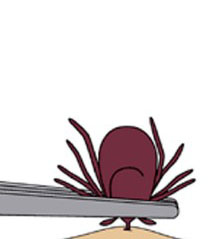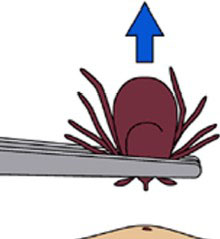 Lyme disease is a bacterial infection which is spread by tick bites and is transmittable to birds and a number of mammals, including humans, dogs, and cats, although cats rarely get the disease.
Lyme disease is a bacterial infection which is spread by tick bites and is transmittable to birds and a number of mammals, including humans, dogs, and cats, although cats rarely get the disease.
Symptoms in humans include a bulls-eye shaped rash around the bite mark, lethargy, joint pain and inflammation, fever, chills, headache, and backache. Symptoms in pets, however, are a little harder to distinguish partly due to the fact that they are also symptoms of many other diseases. The most prominent symptoms mimic arthritis.
Symptoms Include:
 Sensitivity to touch
Sensitivity to touch- Loss of appetite
- Episodes of lameness
- Joint inflammation
- Fever
- Incontinence
Deer and mice are often associated with Lyme disease because they carry the ticks that harbor the disease. Deer and mice, however, are considered carriers because they don’t show symptoms. Experiments have also shown dogs and cats to have a natural immunity to the Lyme disease bacteria, cats in particular.  There is controversy in the veterinary medical field as to whether or not this disease is even defined in cats and dogs. Some believe that the scare about dogs getting Lyme disease is unfounded.
There is controversy in the veterinary medical field as to whether or not this disease is even defined in cats and dogs. Some believe that the scare about dogs getting Lyme disease is unfounded.
In Dr. Pitcairn’s Complete Guide to Natural Health for Dogs and Cats, Dr. Richard Pitcairn tells his readers, “Though scientists have put the organism into dogs many, many times, they cannot reproduce the disease – they cannot cause Lyme disease by injecting the bug into dogs.” The only way these researchers were able to cause mild symptoms to occur in the test dogs was to give the dogs cortisone injections first, because cortisone weakens the immune system. The conclusion that was drawn was that dogs are naturally resistant to Lyme disease, and only animals with a weakened immune system who are in poor health will become symptomatic.
Dr. Meryl Littman practices in an area that is known as a Lyme disease hotspot, and she’s done a great deal of clinical and practical research on the matter. In her area, studies showed that “89.6% of healthy dogs had positive Lyme titers.” This means that most dogs, healthy dogs, have been exposed to the disease, but have not become symptomatic, indicating a natural immunity. The studies also reported, “Only 4.8% of naturally exposed seropositive dogs demonstrated a limb or joint disorder with lethargy, fever, or inappetence; however, 4.6% of seronegative dogs also demonstrated such disorders.” What this means is that the same low percentage of dogs showed symptoms of Lyme disease whether they were carrying the Lyme disease bacteria or not. The result is equivalent to a placebo test that proves inefficacy.
 This is contrary to what most veterinarians tell their clients. Dr. Pitcairn says that when dogs are brought to him with symptoms of Lyme disease, he tells his patients to wait it out. He states, “Usually antibiotics are prescribed and most dogs get better. What is not understood is these dogs will get better anyway. Studies of dogs with these symptoms indicate that eighty-five percent of them recover without any antibiotic treatment at all. The other fifteen percent will continue to have symptoms whether or not antibiotics are used.”
This is contrary to what most veterinarians tell their clients. Dr. Pitcairn says that when dogs are brought to him with symptoms of Lyme disease, he tells his patients to wait it out. He states, “Usually antibiotics are prescribed and most dogs get better. What is not understood is these dogs will get better anyway. Studies of dogs with these symptoms indicate that eighty-five percent of them recover without any antibiotic treatment at all. The other fifteen percent will continue to have symptoms whether or not antibiotics are used.”
While there is much debate about this subject, one thing that most holistic veterinarians agree on is that the Lyme disease vaccination is unnecessary and may even be harmful. Research has not proved that the vaccination prevents Lyme disease. In fact, it seems that over-vaccination causes a weakened immune system, which can make dogs susceptible to the disease.
Tick Removal
The following information is from the Center for Disease Control’s website:
- Use fine-tipped tweezers to grasp the tick as close to the skin’s surface as possible.
- Pull upward with steady, even pressure. Don’t twist or jerk the tick; this can cause the mouth-parts to break off and remain in the skin. If this happens, remove the mouth-parts with tweezers. If you are unable to remove the mouth easily with clean tweezers, leave it alone and let the skin heal.
- After removing the tick, thoroughly clean the bite area and your hands with rubbing alcohol, an iodine scrub, or soap and water.


You may have heard of methods such as burning or painting the tick with an irritating substance, but don’t do this because the tick could regurgitate and cause a hypodermic effect in your pet.
If ticks get out of hand, you must see a holistic veterinarian. Ticks and fleas on your pet can fester to colonies of hundreds and even thousands, which will suck the life out of your pet if not treated.
Herbal and Naturopathic Help
Clearly the best preventative is to keep your pet healthy with a well-functioning immune system. Feed a natural, raw diet and avoid unnecessary vaccinations, antibiotics, and corticosteroid drugs.
The Northeastern states, the Mid-Atlantic states, Georgia, Wisconsin, California, and Michigan are areas with relatively high counts of ticks carrying Lyme disease. If you live in one of these areas, you may want to give your pet some immune boosting nutritionals during tick season. These can include:
 Extra Vitamin C
Extra Vitamin C- Olive Leaf Extract
- Grapefruit Seed Extract
- Maitaki Mushrooms
- Astragalus
- Bee Propolis
- Echinacea
- Zinc
Famed nutritionist Juliette De Bairacli Levy used an herbal tablet made from garlic, rue, sage, thyme, eucalyptus, wormwood, and vegetable charcoal to effectively help treat and prevent Lyme disease. And in The Encyclopedia of Natural Pet Care, CJ Puotinen mentions  a treatment called Auntie Lyme tea which contained liver supporting herbs such as nettle, red clover, burdock seed and milk thistle, plus some nervines, or calming herbs. Helping the liver is good if a pet has shown symptoms of Lyme disease.
a treatment called Auntie Lyme tea which contained liver supporting herbs such as nettle, red clover, burdock seed and milk thistle, plus some nervines, or calming herbs. Helping the liver is good if a pet has shown symptoms of Lyme disease.
If your pet is kept healthy with a nutritious, well-balanced diet, you shouldn’t have a problem with Lyme disease. If your pet does show symptoms of the disease, you may want to take Dr. Pitcairn’s advice, but we have to advise that you contact a holistic veterinarian for guidance. Although rare, Lyme disease has been known to quickly paralyze some animals.
Homeopathy
Some holistic veterinarians recommend giving the nosode Borrelia burgdorferi 60x as a preventative. Give one dose daily for seven days, and then one dose weekly for one month. After that, give one dose once every six months.
 For most cases of Lyme disease, Ledum palustre 1M given three times daily for three days has been effective.
For most cases of Lyme disease, Ledum palustre 1M given three times daily for three days has been effective.
If the disease is caught early on, and there is high fever and agitated fretfulness, give Aconitum napellus 30c once every four hours until symptoms subside. A normal body temperature for a dog or cat is about 101.5°F. If you see no signs of improvement within the first few days, use one of the following treatments for the symptoms described.
If your pet is lying around quietly and movement seems to be very painful, give Bryonia alba 30c once every four hours.
If your pet is stiff and sore, but becomes a little more limber upon moving around, give Rhus tox 30c once every four hours.
 If your pet seems unusually submissive, and isn’t drinking water, give Pulsatilla 30c once every four hours.
If your pet seems unusually submissive, and isn’t drinking water, give Pulsatilla 30c once every four hours.
If your pet is salivating and has reddish, inflamed gums and bad breath in addition to the regular Lyme disease symptoms, give Mercuris vivus 30c once every four hours.
Ferrum Phosphate c6 is a biochemical tissue salt used when there is infection or inflammation. It helps to distribute iron and oxygen throughout the body, strengthen cell walls and fight infection. Aconite c6 is often used for shock or anxiety. And China c6 is used for fever and exhaustion, particularly following illness or severe fluid loss.